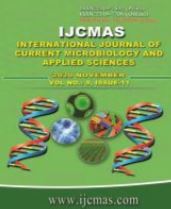


 National Academy of Agricultural Sciences (NAAS)
National Academy of Agricultural Sciences (NAAS)

|
PRINT ISSN : 2319-7692
Online ISSN : 2319-7706 Issues : 12 per year Publisher : Excellent Publishers Email : editorijcmas@gmail.com / submit@ijcmas.com Editor-in-chief: Dr.M.Prakash Index Copernicus ICV 2018: 95.39 NAAS RATING 2020: 5.38 |
Resistance is the genetic ability of some individuals in an arthropod pest population to survive an application or multiple applications of a pesticide. In other words, the pesticide no longer effectively kills a sufficient number of individuals in the arthropod pest population. Resistance develops at the population level and is an inherited trait. As such, surviving arthropod pests can pass traits genetically onto their offspring or next generation, enriching the gene pool with resistant genes (alleles). The amount of “selection pressure,” or the frequency of applying pesticides, is the main factor that influences the ability of an arthropod pest population to develop resistance to pesticides. This then increases the proportion or frequency of resistant individuals. Pesticide resistance in pests has severe negative consequences but can be used as a positive trait for natural enemies as an opportunity to improve the simultaneous use of two very valuable tools in pest management: chemical and biological control. Biological control adoption is limited in some areas, crops, or seasons due to the imperative use of pesticides needed to control diseases and pests. Most studies on pesticides and natural enemies try to establish the degree of compatibility using only a population, not considering the natural variation in insecticide susceptibility. However, there is variation in the response to pesticides among populations of a beneficial species, similarly to the response in any pest species. Knowledge of the natural and potential variation in the tolerance of natural enemies to pesticides may improve the design of robust IPM strategies by extending the role of biological control in some agricultural systems and by increasing the number of available compounds to control diseases and key, secondary, and invasive pests. There are a number of excellent revisions on pesticide resistance in natural enemies. In the present review, new cases of insecticide resistance in natural enemies are discussed, as a better understanding of pesticide resistance in natural enemies will allow us to enhance the integration of chemical and biological tools in IPM programs this time period.
 |
 |
 |
 |
 |